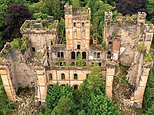
Scotland is one of the world’s most historically fascinating countries – as is evident from this book of deserted treasures.
Abandoned Scotland, by Alastair Horne, published by Amber Books, is a beautifully illustrated compendium of ‘little-known corners’ across the country.
The book is packed with 180 photographs of abandoned relics, taking readers on an enthralling tour on which they’ll see a ghostly ski station, ruined castles, a run-down bathhouse, a former dynamite factory and more – all the while taking in some of the country’s most ‘stunning landscapes’.
In his introduction to the book, Horne writes: ‘A book possessing the title Abandoned Scotland might perhaps be expected to tell a story of a nation in decline. And yet the next five chapters, which explore Scotland’s castles, its industrial and urban heritage, its rural and religious ruins along with its military relics, have more than a little to say about the country’s future as well as its past.’
‘So many of these abandoned places show signs of new life,’ he says, adding that ‘an abandoned Scotland is still a positive, beautiful Scotland’.
Scroll down for a sneak preview of 17 deserted sites that appear in the tome, with caption information courtesy of the author…
WOODHEAD LEAD MINE, GALLOWAY: Explaining the isolated ruins in the picture above, Horne writes: ‘More than 300 people worked at Woodhead lead mine in Carsphairn at its peak in 1851, many living in cottages built by local landowner, Colonel MacAdam Cathcart. The mine closed in 1873’
LENNOX CASTLE EAST DUNBARTONSHIRE: Horne explains that Lennox Castle was built between 1837 and 1841 and housed nurses working at a hospital built in the grounds for most of the 20th century. He adds: ‘After the hospital’s closure in 2002, a fire in 2008 left the castle building in ruins’
SCAPA FLOW BLOCKSHIP, ORKNEY: ‘During World War I ships were deliberately sunk in Scapa Flow to prevent German ships and submarines from accessing the sheltered waters of the Orkneys,’ writes Horne. ‘Some were replaced during World War II, but many of these “blockships” still remain’
DERELICT KITCHEN, LEWIS AND HARRIS ISLAND, OUTER HEBRIDES: ‘With a jug still standing by the sink and a teapot on the side, this kitchen looks as if it was abandoned in a hurry,’ says Horne of this scene
HOLYROOD ABBEY, EDINBURGH: ‘This magnificent medieval Gothic nave is the only part of Holyrood Abbey still standing today,’ the book reveals. Delving into the history of the ruined abbey, Horne writes: ‘The Parliament of Scotland met here several times between 1256 and 1410, and the abbey served also as a residence for several Scottish kings’
DALQUHARRAN CASTLE, SOUTH AYRSHIRE: This spiralling staircase can be found in Dalquharran Castle, which was designed by architect Robert Adam, the Horne reveals. He explains that it ‘served as the home of the Kennedy family from its completion in 1790 until the 1930s’, adding: ‘The removal of its lead roof in 1967 – reportedly to avoid the payment of taxes due on habitable buildings – soon led to it becoming overgrown’
TANK TRAPS, LOSSIEMOUTH, MORAY: In the book, Horne notes that this line of concrete tank traps stretch ‘incongruously through acres of woodland’. Explaining the historical objects, he says they ‘formed part of the Moray coastal defences during World War II, pre-dating the pines that have grown up around them’
GOVANHILL BATHS, GLASGOW: In his chapter ‘Transport, Industrial and Urban Sites’, Horne shows the disused Govanhill Baths in Glasgow. He writes: ‘On its opening in 1917, the Govanhill Baths in Glasgow combined a swimming pool, public baths and individual “slipper baths” with a laundry. After their closure in 2001, a community trust was established and the site partially reopened in 2012.’ The book says that the baths are expected to fully reopen in 2024 ‘as a community well-being centre’
BRITISH DYNAMITE FACTORY, ARDEER: The book reveals that Alfred Nobel, the founder of the Nobel Prize, was also the inventor of dynamite. Horne writes: ‘His British Dynamite Company opened its first factory in Ardeer on the Ayrshire coast in 1871.’ He continues: ‘Its coastal location was ideal for the safe transportation of its products, which could not be moved by rail’
CASTLE STALKER, LOCH LAICH, ARGYLL: In his chapter on abandoned castles, Horne presents Castle Stalker, which he explains is ‘situated in on a small tidal islet in Loch Laich’. He says Scotland’s castles ‘provide fascinating insights into the country’s eventful and often bloody history’. Explaining the history of Castle Stalker, he says it takes its name from the Gaelic word Stalcaire, ‘meaning hunter or falconer’. He continues: ‘Lost to the Campbells of Airds in a drunken bet in the 1620s, the castle was recaptured by the Stewarts in the 1680s’
SCARISTA BUS, ISLE OF HARRIS: This abandoned bus, Horne reveals, ‘sits near the beach of Scarista on the south-western coast of the Isle of Harris’. Sharing details of the bus’s history, he writes: ‘Once owned by local company Maclennan Coaches of Stornoway, it was later converted for use by a local scout troop’
SKI LIFT, HIGHLANDS: ‘The mountains of Scotland have long been in demand with skiers, with resorts at Glencoe, Glenshee, Cairngorm, the Lecht and Nevis Range proving highly popular,’ Horne writes. However, he says this resort at the Mar Lodge estate in Deeside ‘was less successful’, revealing that it closed after ‘only two seasons’
SUNSET AT AIRIDH A’ BHRUAICH, LEWIS AND HARRIS: In his chapter ‘Rural Cottages, Crofts & Islands’, Horne includes this picture of an abandoned farmhouse at sunset. Detailing its location, he says it ‘is perched at the edge of Loch Seaforth, part of the scattered crofting community of Airidh a’ Bhruaich in the Lewis island area’
DUNSKEY CASTLE, STRANRAER: Describing this abandoned castle perched on the coastline, Horne writes: ‘The picturesque ruins of 12th-century Dunskey Castle stand on a rocky promontory on Scotland’s south-west coast, just south of Portpatrick’
KEISS CASTLE, CAITHNESS: The author says Keiss Castle stands ‘dramatically on the very edge of the steep cliffs overlooking Sinclair’s Bay’, which lies in east Caithness, in the district of the east Highlands. He notes that the castle is just 13km (eight miles) away from John O’Groats. He continues: ‘The ruined tower house of old Keiss Castle was built in around 1600 by the 5th Earl of Caithness, George Sinclair’
DUNURE CASTLE, SOUTH AYRSHIRE: ‘The ruins of Dunure Castle stand on the shore of the Firth of Clyde, overlooking nearby Dunure harbour’, Horne writes. He adds: ‘The distinctive round building to the left of the castle is a beehive doocot (dovecote), which would have held around 200 nesting boxes for doves or pigeons’
ARROL-JOHNSTON CAR FACTORY, DUMFRIES: ‘Standing on the outskirts of Dumfries and built from reinforced concrete and brick, the Arrol-Johnston Car Factory opened at Heathhall in 1913,’ Horne writes about this abandoned factory shown through a broken-glass window. He says it was designed by architect Albert Kahn and modelled on the factories of Henry Ford, noting that it closed 18 years after opening
All images are taken from the book Abandoned Scotland by Alastair Horne (ISBN 978-1-83886-314-2), published by Amber Books Ltd (www.amberbooks.co.uk) and available from bookshops and online booksellers (RRP £19.99/$29.99/CAN$38.99)
Source link
CHECK OUT: Top Travel Destinations
READ MORE: Travel News



